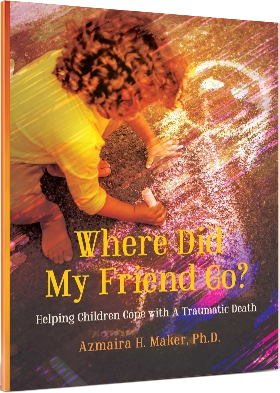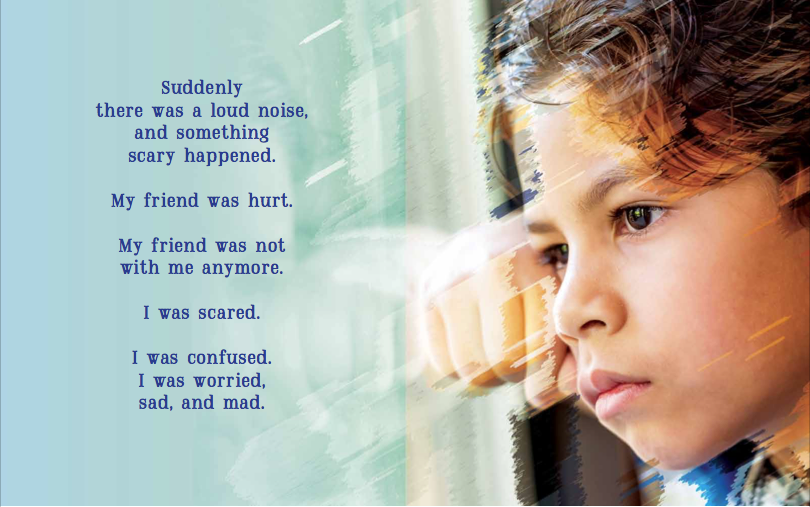
WHERE DID MY FRIEND GO?

Where Did My Friend Go? A Children’s Book About Death
The book begins a dialogue about sudden death, addresses what happened, identifies feelings, explores fears, confusion, and loss, helps the child cope with the trauma and grief, and reassures the child with safe tools. It is a first step, cost-effective, and immediate mental health intervention for the youngest survivors and witnesses of sudden or traumatic death.
Death is inevitable; it’s a part of life. As adults, we have a lifetime’s worth of experience in handling grief — children, however, are new to these difficult and heartbreaking emotions.
Without the right guidance, death can be a very confusing and overwhelming concept for a child to grasp. As parents, grandparents, and guardians, it is our duty to understand how to explain death to children in a healthy, honest, and responsible way as it will lay the foundation of their relationship with the concept.
This is especially challenging for most parents because it is a natural instinct for them to want to protect their children from the whole subject of death, loss, grief, funerals, and sadness. They might feel that the children are too young to understand and that the information would harm them.
Children are exceptionally imaginative and their conscious reality is very different from ours. Because their thought processes are so malleable, everything they learn at a young age will contribute to the way they see the world at a later stage in life.
With that in mind, the words you use to explain death is a very important consideration to make as it can have far-reaching effects on their mental well-being.
An effective way of explaining the concept to toddlers is using books specifically designed for them to grasp the concept in a way they can comprehend.
Why This Subject Is More Important Than Ever
The American Academy of Pediatrics has identified gun shootings as the second leading cause of death for children and teenagers and a national health crisis.
- The Brady Campaign reports that there have been 160+ school shootings in the U.S. since Sandy Hook.
- The Brady Campaign reports that every day, 7 children and teens die of gun violence, and every day 40 children are shot and survive in the U.S.
- More than 1 in 5 U.S. children and teenagers report having witnessed a shooting, with PTSD, depression, anger, withdrawal, and desensitization to violence being some of the outcomes.
- It is hard to believe that American kids die by guns 11 times more often than children in other high-income countries.
Our hope is that people come together as a community to share this project with family, friends, neighbors, colleagues, schools, and organizations to continue to raise funds and visibility for this cause.
What Not To Say When Explaining Death to Children
You might wonder whether the use of words like “dead” or “death” is okay. These are in fact, household words that children hear all the time. They see dead birds in the garden, dead plants in the pot, and dead insects on the lawn. We even use words such as “dead tired”, “dead scared”, and “drop-dead gorgeous”.
Children have heard these words before — the difference is that when someone familiar dies, they need to learn that “death” happens to people too, and it might happen to somebody they love. The idea is to use words that are simple and appropriate for their age.
When explaining the concept of death to children, to make sure that they grieve normally, it is important to avoid a specific set of words and euphemisms.
Since children only hear the words that we actually say and not what we meant underneath, they cannot comprehend the complexity behind euphemisms. They’ll derive meanings that are within their brain’s capacity of comprehension, which might lead to unwanted thought patterns.
Here are a few examples:
“She went to sleep forever“: Saying that being dead is like sleeping can be very confusing and even frightening for a child. The thought of going to sleep and not waking up is really scary — you do not want to instill a fear of sleep.
“We lost him“: Saying that we “lost someone” can also be scary because children lose things all the time, then they try and look for what’s lost. Saying this can take away their sense of closure.
“She went away to sleep with the angels“: Saying that someone went away can lead to a feeling of guilt and abandonment.
Instead, words that are straightforward, logical, and simple will work better.
For example: “When someone dies, their heart stops working. So they can’t breathe, which is what keeps them alive. They can’t move anymore, they can’t talk, they can’t play, they don’t eat, they can’t open their eyes. Their whole body stops working. That’s what we mean when we say someone is dead.”
It is heartbreaking, but we cannot teach our children to deal with grief by not talking about it. Remember that children learn to cope with their feelings by watching what their parents do in similar situations.
It takes a village to help kids thrive.

Testimonials
Midwest Book Review
Donovan, CA Bookwatch.
Krista Roybal, M.D., Executive Medical Director, True Life Center for Wellbeing.
M. Crowe, M.A. Child Development, Institute for Public Health, San Diego State University.